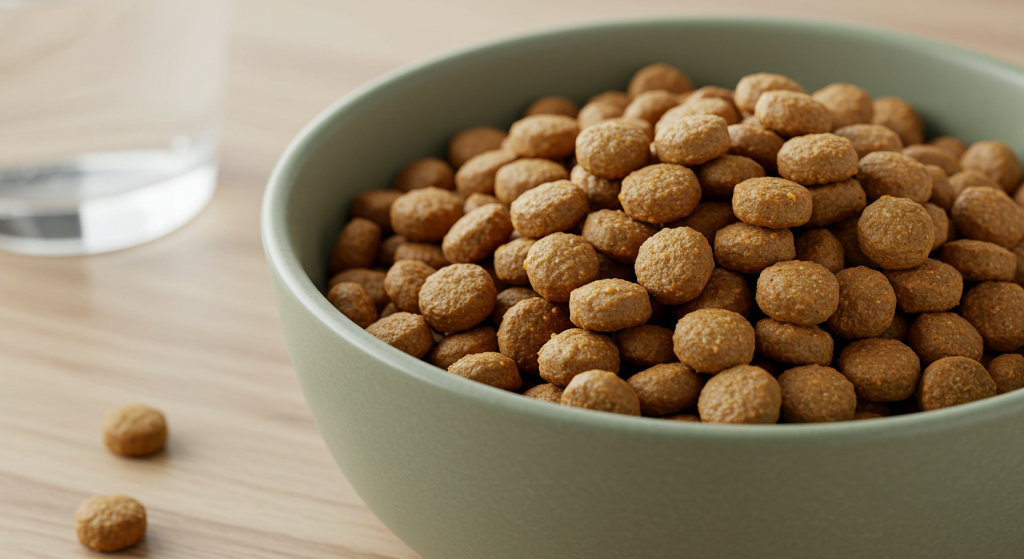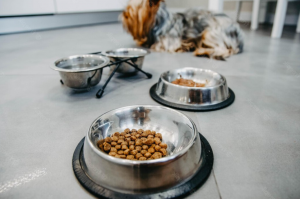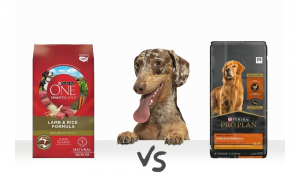Dogs with allergies often struggle to find a balanced diet that doesn’t aggravate their symptoms. If you’ve noticed your furry friend scratching, experiencing digestive issues, or showing signs of discomfort, you’re not alone. According to the American Kennel Club (AKC), food sensitivities affect many breeds and can lead to chronic issues like ear infections or stomach upset. This article explores the best dog food for allergies and provides you with practical solutions, reputable sources, and clarity on how to help your canine companion feel better.
What We'll Cover
- What Are the Signs of Dog Food Allergies?
- Common Allergens in Dog Food
- Why Some Dogs Are Prone to Allergies
- Finding the Best Dog Food for Allergies
- 1. Limited-Ingredient Diets
- 2. Novel Protein Diets
- 3. Hydrolyzed Protein Diets
- 4. Grain-Free vs. Grain-Inclusive
- 5. Homemade and Raw Diets
- 5 Best Dog Foods for Allergies on Amazon
- Hill’s Prescription Diet z/d
- Royal Canin Veterinary Diet Hydrolyzed Protein
- Purina Pro Plan Veterinary Diets HA
- Natural Balance L.I.D. Limited Ingredient Diets
- Blue Buffalo Basics Limited Ingredient Diet
- Creating an Elimination Plan
- Step 1: Consult Your Veterinarian
- Step 2: Start an Elimination Diet
- Step 3: Reintroduce Ingredients Slowly
- Simple Daily Feeding Calculation
- FAQs
- “What dog food is best for a dog with allergies?”
- “How do I know if my dog has a food allergy?”
- “Is grain-free dog food good for allergies?”
- “What ingredients should I avoid?”
- Practical Tips and Next Steps
- Natural Ways to Support Allergy Relief
- Conclusion: A Path to Comfort and Health
What Are the Signs of Dog Food Allergies?

A dog suffering from food allergies may experience frequent ear infections, gastrointestinal upset, and extreme itchiness, especially around the face, paws, and rear. Some pets might lick or scratch obsessively until their skin becomes red or raw. If you spot these signs, consult a veterinarian. They can confirm whether the cause is food-related or the result of environmental factors like pollen or fleas.
Important Note: This article is for educational purposes and does not replace professional veterinary advice.
Common Allergens in Dog Food

Many commercial dog foods use protein sources like beef, chicken, dairy, and eggs. While these are nutritious for most dogs, they can trigger allergic reactions in sensitive pups. Grains (wheat, soy, and corn) can also cause discomfort in some canines, although true grain allergies are less common than protein allergies.
Why Some Dogs Are Prone to Allergies

Certain breeds (e.g., retrievers, bulldogs, and terriers) have a higher predisposition to allergic reactions. Genetics and immune system responses also play a significant role. In some cases, a dog’s body mistakenly identifies proteins as harmful, leading to inflammation and discomfort. Over time, repeated exposure to these allergens can worsen symptoms.
Finding the Best Dog Food for Allergies

1. Limited-Ingredient Diets
A limited-ingredient diet (LID) typically contains one primary protein source and one carbohydrate source. This simplicity helps pet owners pinpoint exactly which foods trigger their dog’s allergic reaction. If your vet recommends an elimination diet, LIDs can be an excellent starting point.
Sample LID Ingredients Table
| Protein Source | Carbohydrate Source | Possible Benefits |
|---|---|---|
| Venison | Sweet Potato | Novel protein; often well-tolerated |
| Duck | Brown Rice | Fewer allergens than chicken or beef |
| Salmon | Pea | High in omega-3s; helps skin & coat health |
Choose proteins and carbs your dog hasn’t tried before to identify or avoid allergens more effectively.
2. Novel Protein Diets
A novel protein is one your dog’s body has never encountered. For instance, switching from chicken-based food to formulas containing kangaroo, rabbit, or bison may prevent allergic flare-ups. Novel proteins reduce the immune system’s tendency to overreact.
3. Hydrolyzed Protein Diets
Hydrolyzed protein dog foods break down protein molecules into smaller pieces. These tiny protein fragments are less likely to trigger an immune response. Many veterinary prescription diets offer hydrolyzed formulas to help dogs with severe food allergies.
4. Grain-Free vs. Grain-Inclusive
Grain-free diets are popular, but they aren’t necessarily the answer for all dogs with allergies. Current research from the U.S. Food and Drug Administration (FDA) suggests possible links between certain grain-free diets and heart conditions in dogs, though studies are ongoing. If your dog isn’t specifically allergic to grains, consider high-quality, grain-inclusive formulas that contain whole grains like brown rice or oatmeal.
5. Homemade and Raw Diets
Some owners opt to make dog food at home to control every ingredient. Homemade diets can be beneficial if carefully balanced, but they require significant time, effort, and knowledge. Improperly balanced meals can lead to nutritional deficiencies. Raw diets may also appeal to some, yet they carry risks of bacterial contamination. Always consult with a veterinary nutritionist or your vet before transitioning to a homemade or raw diet.
5 Best Dog Foods for Allergies on Amazon
Below are five reputable dog food options for sensitive pups. While each product has distinct benefits, always discuss major diet changes with your veterinarian to ensure the best fit.
Hill’s Prescription Diet z/d

Hill's Prescription Diet z/d Skin/Food Sensitivities Dry Dog Food is specially formulated by Hill’s nutritionists and veterinarians to support your dog’s skin and food sensitivities
Clinically test...
- Key Feature: Hydrolyzed protein to minimize adverse reactions.
- Why It’s Good: Specially formulated for dogs with severe skin and food sensitivities.
- Note: Veterinary authorization is often required for purchase.
Royal Canin Veterinary Diet Hydrolyzed Protein

Boosted omega-3 fatty acids to improve your dog's skin health and coat luster
Chelated minerals that can be easily absorbed by your pet's body
Hydrolyzed soy protein that won't upset your pet's sys...
- Key Feature: Uses hydrolyzed soy protein to reduce the risk of allergic reactions.
- Why It’s Good: Carefully crafted for dogs prone to digestive issues and itching.
- Note: This is a prescription diet; consult your vet to ensure it’s right for your dog.
Purina Pro Plan Veterinary Diets HA

Formula contains hydrolyzed protein sources
Single carbohydrate source
Highly digestible to promote optimal nutrient absorption
High-quality protein
Contains antioxidants
- Key Feature: Hydrolyzed formula designed for easy digestion.
- Why It’s Good: Minimal ingredient list, which helps isolate potential allergens.
- Note: Comes highly recommended by many veterinarians for dogs with persistent allergies.
Natural Balance L.I.D. Limited Ingredient Diets

LAMB IS THE FIRST INGREDIENT providing essential protein and amino acids to help maintain strong muscles; Brown Rice is included as a healthy and rich source of fiber for digestive health; Contains...
- Key Feature: Single-source protein options (e.g., duck, salmon, or venison) and limited carbs.
- Why It’s Good: Great for elimination diets; often well-received by dogs with mild-to-moderate allergies.
- Note: Multiple flavors and protein sources offer variety for picky eaters.
Blue Buffalo Basics Limited Ingredient Diet

REAL SALMON FIRST: This Blue Buffalo dry dog food is made with real, high-quality salmon as the #1 ingredient
ADULT DOG FORMULA: This natural dog food with wholesome grains is formulated with healt...
- Key Feature: Formulated without chicken, beef, dairy, corn, wheat, or soy.
- Why It’s Good: Contains omega-3 and omega-6 fatty acids to support skin health.
- Note: Widely available and suitable for many dogs with mild allergies or sensitivities.
Creating an Elimination Plan

Step 1: Consult Your Veterinarian
Before changing your dog’s diet, gather professional input. A veterinarian might recommend tests (like blood or skin patch tests) to rule out environmental triggers. They may also guide you on the exact protein source or commercial brand to try.
Step 2: Start an Elimination Diet
An elimination diet involves feeding your dog a limited or novel protein for about 8–12 weeks. This time frame gives the body a chance to clear out allergens. If symptoms improve significantly, it’s likely that the eliminated ingredient was the culprit.
Step 3: Reintroduce Ingredients Slowly
After the initial period, reintroduce one ingredient at a time—such as chicken or wheat—and watch for a reaction. If symptoms return, you’ve identified a potential allergen. This slow process is crucial to pinpoint the specific trigger.
Simple Daily Feeding Calculation
It’s helpful to calculate your dog’s approximate Daily Energy Requirement (DER) to ensure you’re feeding the proper amount. One common formula is:
RER (Resting Energy Requirement) = 70 × (Body Weight in kg^0.75)
DER = RER × Activity Factor
-
Activity Factor varies by dog:
- Sedentary dogs: 1.2 – 1.4
- Moderately active dogs: 1.4 – 1.6
- Highly active or working dogs: 1.6 – 2.0
For example, if your 10 kg dog is moderately active:
RER = 70 × (10^0.75) ≈ 70 × 5.62 = 393.4
DER = 393.4 × 1.5 ≈ 590 calories per day
Adjust this number based on your vet’s recommendation and your dog’s actual response.
FAQs

“What dog food is best for a dog with allergies?”
There is no one-size-fits-all answer, but the best dog food for allergies usually has:
- A single, novel protein (e.g., rabbit, duck, venison).
- Limited, high-quality ingredients without artificial additives.
- Adequate omega-3 and omega-6 fatty acids for skin and coat health.
“How do I know if my dog has a food allergy?”
Look for chronic, recurring symptoms such as itchy skin, recurrent ear infections, or digestive distress. Work with your vet for a definitive diagnosis and consider an elimination diet to identify triggers.
“Is grain-free dog food good for allergies?”
Grain-free options can help if your dog is allergic to wheat, corn, or soy. However, many dogs with food sensitivities react more often to proteins (chicken, beef, dairy). It’s best to confirm the true allergen before switching to a grain-free formula.
“What ingredients should I avoid?”
Avoid common culprits like chicken, beef, dairy, eggs, and wheat if your dog is known to react to these. Focus on limited-ingredient formulas or novel proteins.
Practical Tips and Next Steps

- Track Symptoms: Keep a journal of what your dog eats and any related symptoms. This documentation can help you and your vet identify patterns.
- Transition Slowly: Whenever you change your dog’s diet, introduce the new food gradually over 7–10 days to reduce GI upset.
- Consider Quality: Look for products with the Association of American Feed Control Officials (AAFCO) statement to ensure complete and balanced nutrition.
- Stay Patient: Finding the right food may involve trial and error. Don’t be discouraged if the first attempt doesn’t yield perfect results.
Natural Ways to Support Allergy Relief

- Omega-3 Fatty Acids: Sources like fish oil may help with skin inflammation and itching.
- Probiotics: A healthy gut can strengthen the immune system. Consider probiotic supplements recommended by your vet.
- Regular Bathing: Hypoallergenic shampoos can remove environmental allergens from your dog’s coat.
Conclusion: A Path to Comfort and Health
Finding the best dog food for allergies can feel like a daunting process. Yet with careful observation, the guidance of a veterinarian, and an elimination diet approach, most dogs can find relief. Watch for improvement in skin condition, energy levels, and digestion as you make dietary adjustments. Once you see progress, maintain consistency and work with your vet to ensure your dog gets all the nutrients they need.
Key Takeaways:
- Identify common allergens and consider a limited-ingredient or hydrolyzed diet.
- Consult your veterinarian before making major dietary changes.
- Document symptoms, reintroduce foods slowly, and evaluate the results.
- Supplement with omega-3s and probiotics to help reduce inflammation.
- Remember that every dog is unique—keep experimenting until you find the perfect match.
By following these steps and prioritizing quality ingredients, you’ll be on your way to ensuring a happier, healthier life for your canine companion. Stay patient, stay informed, and keep an open dialogue with your veterinary team. Your dog’s comfort and well-being are well worth the effort.
The responses below are not provided, commissioned, reviewed, approved, or otherwise endorsed by any financial entity or advertiser. It is not the advertiser’s responsibility to ensure all posts and/or questions are answered.








